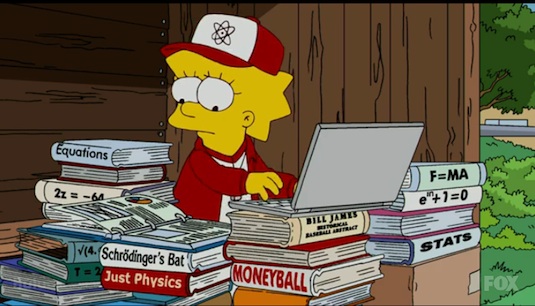
People fear what they do not understand. There’s no way to deny that. The truth is, baseball is still a game where people continue to hold on to “the way things used to be” in their hearts.
It’s why there is no full replay yet, it’s why people are against the DH in the NL even though the NL is at a disadvantage during the regular season or AL during the World Series… or why people don’t like interleague play when in reality if every team plays every team an equal # of times, you’ll get a better idea of who the best teams are.
Stats are the same way. If you use ANY stats to evaluate players, then to me you shouldn’t turn your nose at people who use different stats that you.
When Henry Chadwick came up with Batting Average and ERA, you probably would have seen the same type of attitude about those stats that you do with some sabr stats today. Why? Because fans and executives knew what they knew without needing the help of some silly mathematical formula.
It’s information. Information isn’t the problem, it’s how you utilize that information that makes or breaks the value of the info. Most people I have found who “hate” sabermetrics, haven’t even given them a chance and just dislike a non-traditionalist view of the sport they grew up with.
If I write down step by step instructions on how to change a light bulb and you take that information and the light doesn’t turn on – that doesn’t mean the information I gave was wrong, it means the execution of the information was flawed. We’re all humans, and nobody has ever claimed that sabermetrics give you THE answer. You may evaluate a sabermetric stat differently than I do.
Gaining more information about a player can hurt or help a fan or executive. It depends on how much they rely on this information and how they interpret it that will dictate whether it helps or hurts.
In my experience, fans can go overboard with sabermetric analysis on both sides of the table. I believe in the value of information, and scouting. I believe a batting average can tell you as a fan enough about a player, but it might not be the best statistic to use when investing $100million on a player.
The truth is, every team has access to the basic information but they choose different ways to interpret and analyze the data. The Tampa Bay Rays in all likelihood have different statistical formulas for player evaluation than say the average fan has access to.
What sabermetrics do a better job at than “traditional” statistics is they try to explain in more detail why something is happening that perhaps is a fluke. For example, it might help you understand why a pitcher with bad statistics (traditional) appears to be struggling, but perhaps he isn’t as bad as those numbers make you believe. This can help a GM find talent that is perhaps underappreciated.
Where sabermetrics fails is defining and evaluating character. You cannot put a value on a player like Marco Scutaro or Yadier Molina using sabermetrics. They bring something to the table that statistical analysis cannot define. Besides their on the field presence, they clearly make all of the players around them better. You cannot replace that, and it’s very hard to find.
I rarely if ever use sabermetrics to evaluate a player I like. When it comes to pitchers, I like W, L, SV, ERA, IP/K, BB/K, HR, IR/IRS and WHIP. With hitters I like Doubles, Triples, HR, RBI, BB, K, SB, AVG, OBP, SLG, and OPS.
Those statistics put me almost all the way toward “traditionalist,” but you will never, ever find me scoffing at somebody who uses sabermetrics because the more information you have – the better you can understand what is in front of you.














